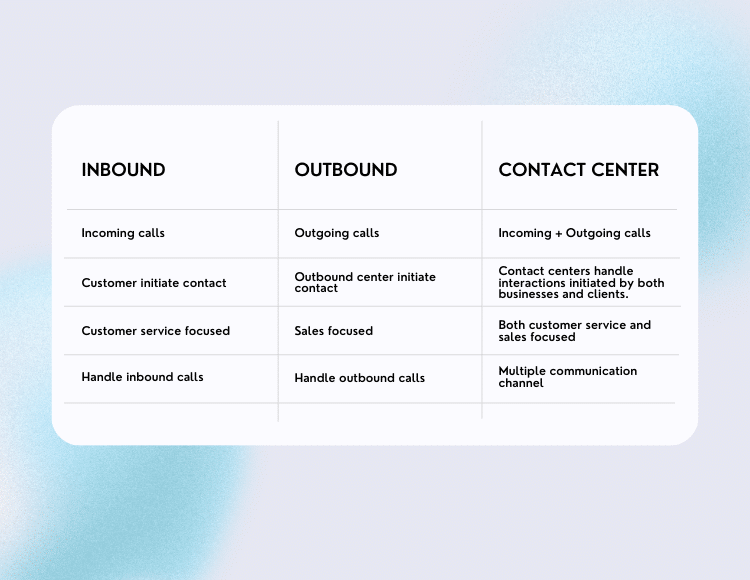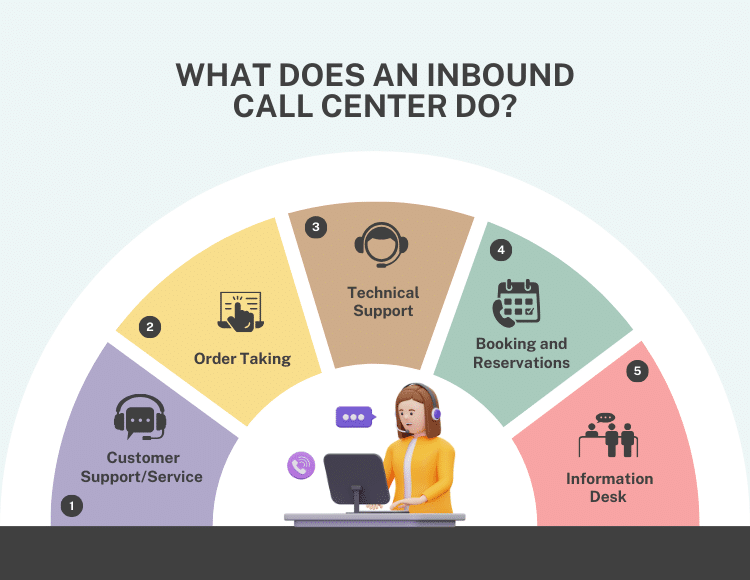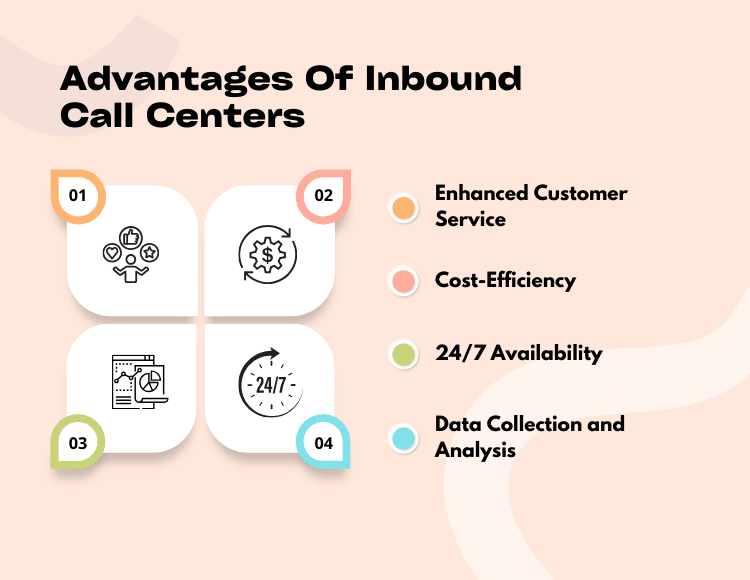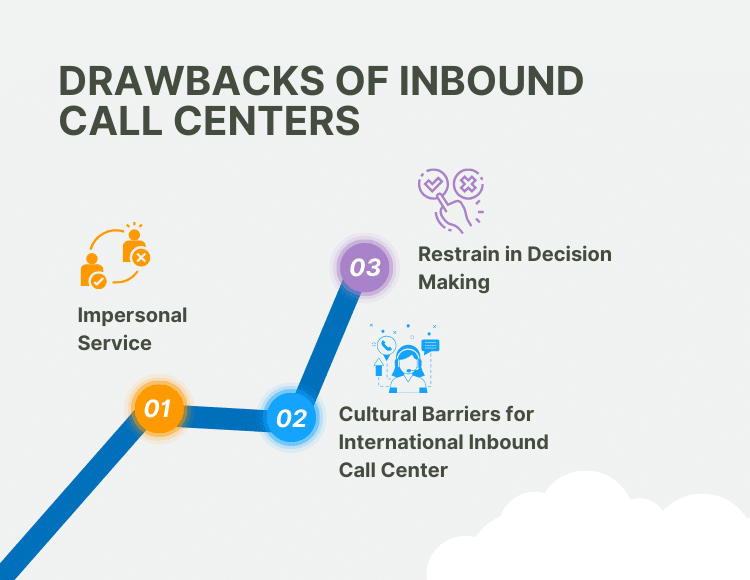How Does Inbound Call Center Work? It is one of the most common questions. Well, an inbound call center functions by receiving incoming calls from customers to provide assistance, information, or solutions to their inquiries, which relies on skilled agents and technology mainly.
To foster positive relationships with customers and enhance their customer service experience, nothing can replace an inbound call center. Unlike outbound call centers, here the customer initiates the call that fills the sales funnel with prospects.
This is a systematic and permissive based approach. And to see new heights in your business, an inbound call center is a must.
So, today, we will discuss in-depth what an inbound call center is, the difference between inbound, outbound and contact call centers, and how inbound call centers work.
What Is an Inbound Call Center?
An inbound call center is a customer-centered, structured, non-intrusive service where the primary purpose is handling incoming calls by a team of skilled agents.
The main focus is building solid relationships with customers by giving them the best service, which in return helps in business growth.
Inbound calls can also be considered a crucial step of the sales funnel, where the most lead generation depends on it.
Five key features typically characterize an inbound call center:
- Customer-oriented.
- Two-way communication.
- Multi-functional.
- Technology-driven.
- Permissive based.
Here, businesses do not interrupt people’s daily life. Instead, customers initiate these calls when they need help, have any questions or require assistance with the product or service. They can even make a purchasing decision and, most often, are pre-interested.
Companies provide a phone number that customers use to reach out whenever they need it. This involves a good content marketing approach.
Next, inbound agents work effortlessly to provide a high level of customer service. They are trained to be responsive, empathetic, and knowledgeable in addressing customer concerns.
Besides, inbound call center services handle a wide range of tasks, including general information requests, technical support, product troubleshooting, order processing, billing inquiries, and complaint resolution.
All these require advanced telephony and call center software like Automatic Call Distribution (ACD) systems and Interactive Voice Response (IVR) systems. This ensures an efficient route, manages incoming calls, and provides agents with relevant customer data.
Tips for Inbound Call Center to Work Better
Here are some tricks to better your inbound call center strategy.
- Direct the inbound calls to specific agents based on the nature of the inquiry, the skills and expertise required to address it. This ensures that customers are connected to the most qualified agents.
- Segment your inbound service levels based on priority. If there is a high chance for any client to become an immediate lead, communicate with them first. For others with a possibility of becoming potential customers, start following up. Then go for the rest of the clients.
- Try to maintain a toll-free number so clients can always call you. With good content marketing, be aware of where you should place the contact information. This widens the possibility for your customer to see the number easily.
The Differences Between Inbound, Outbound & Contact Center?

The main difference between inbound, outbound and contact centers is the direction of engagement and approach.
In the realm of customer service and communications, these three are the main types of call centers.
All of them have their own strategies and working principles. Still, marketers tend to raise confusion between them.
There are some slight differences given below so you can differentiate them better.
Direction of Interaction
- Inbound centers handle incoming calls from clients.
- Outbound centers make outgoing calls to clients.
- Contact centers handle both incoming and outgoing calls.
Customer Initiation
- In the inbound center, customers take the initiative to make a call.
- Outbound centers initiate calls to reach out to customers proactively.
- Contact centers handle interactions initiated by both businesses and clients.
Primary Functions
- Inbound centers focus on customer inquiries and support.
- Outbound centers concentrate on sales, marketing, and proactive outreach.
- Contact centers combine both inbound and outbound capabilities, offering a broader range of services.
Channels Supported
- Inbound centers typically handle phone calls.
- Outbound centers predominantly use outbound calling.
- Contact centers support multiple communication channels, such as email, chat, phone and social media.
Examples of Use Cases
- Inbound telemarketing, customer service hotlines, technical support centers, order inquiry lines and helpdesk support are inbound service centers.
- Examples of outbound call centers are telemarketing agencies, outbound telemarketing, collections agencies, sales call centers, and market research firms.
- Multichannel customer support centers, customer engagement hubs, and organizations that provide a combination of customer service and proactive outreach are the contact center services.
While inbound centers focus on customer inquiries and support, outbound centers are more oriented toward sales and marketing, and contact centers provide a broader approach to customer engagement.
What Does an Inbound Call Center Do?

For the efficiency of inbound call centers, marketers are diverting to this kind of service. Here are some of the key functions and activities that an inbound service typically handles.
1. Customer Support/Service
Customer support or service is the most common type of inbound center and is primarily used. This is a two-way communication method, where the customers can make a call whenever they feel the necessity.
This type of organization only focuses on customer satisfaction.
Usually, the process starts with a call, where the customer first comes into interacting with an Interactive Voice Response or IVR. Right after that, the call is transferred to the suitable department or an agent.
Here, the role of a customer service rep comes into play. He needs to be well-trained, professional, and have a deep knowledge of the company and service.
The tricks can be listening to the customer’s issues and points after giving a short, interactive intro. Then, take action according to the customer’s needs.
If it is an inbound sales service center, then after solving all the problems of a customer, the sales rep cleverly tries to sell the service.
He needs to know how to gauge the interest of the client with the first approach because the first impression is the last. If the client does not feel comfortable or interested, he may not continue the conversation.
Service centers can also act as taking complaints from users. Besides solving problems, this can be a complaint hotline.
2. Order Taking
Inbound call centers are most often equipped with taking or confirming orders and solving any purchasing-related problems.
In inbound marketing, people get interested in the product or service through different types of attractive content. Then, if they decide to purchase the product or have any product-related issues, they call the centers.
Here, the sales rep confirms the order, takes payment and gives a date for delivering the product.
Sometimes, prospects may have pricing issues or want to know more about the product, the future outcome and so on. In that case, the agent needs to cleverly handle the task so the customer does not lose interest.
3. Technical Support
Many inbound centers have specialized teams for technical support. Especially those businesses related to technical products.
After or before purchasing a particular item, people might get confused about the usage or other functionality. Thus, contact the centers to resolve the problem.
Agents try to answer all of the questions, and if necessary, they may route the call to the experts. There, they may provide step-by-step guidance, troubleshoot problems remotely, and escalate issues when necessary.
While transferring the call or if all the team members are busy with others, the incoming calls stay in a queue.
To give good technical support, the team must need relatable knowledge and excellent experience.
4. Booking and Reservations
Inbound servicing centers often handle bookings and reservations for various industries, such as travel, hospitality, event management or even B2B appointment setting.
Customers can call to make reservations for flights, hotels, restaurants, events, and more. Inbounders assist them with the availability, pricing, booking options or confirming the reservation.
During the call, agents can access customer personal information and need to add additional information. Based on these, they can give personal recommendations or help to choose what is most suitable.
There can be cancellation of phone calls many times. In this situation, sales reps have to show respect for the decision.
5. Information Desk
Inbound call centers can work excellently regarding the information desk. Callers can seek information many times and contact the service center.
The inquiries can be related to product specifications, business hours, meeting schedule timing, and event details. Some people also want to know about the business, their history and so on.
Especially in the B2B business, they contact the information desk for general knowledge. So they can decide if they want to make the deal or not.
6. Billing and Account Queries
Inbound call service centers often handle inquiries related to billing, account statements, payment processing, and account management.
Customers may call to inquire about their bills, update their account information, or seek clarification on charges or how to pay.
The agents help them by giving information about where and how much the customer needs to pay. If they are not clear with the payment method or need to pay in another way, reps take steps according to that.
For example, the customer may not have any bank account to pay, hence want to pay in cash. Both the company and users need to make these things clear.
7. Feedback and Surveys
Many companies use inbound calls or quality assurance teams that monitor the calls, take customer feedback and conduct surveys. Agents call the users to gather opinions about the service and include them in the database.
The team then analyzes the result to find out where necessary improvement is required. Or if the quality of the product is OK.
Many times, if the customer is not happy with the service provided by the agents, they may be re-trained or replaced.
8. Emergency Services
For handling urgent and emergency phone calls, some inbound call centers work effortlessly. In the healthcare, fire sectors, crisis helplines, hotlines or emergency consultation involves this kind of service.
These businesses need to be active 24/7 to help needy people at any time. It can be the middle of the night or any hour of the day.
Government services such as 999-national services help the citizens all over the country. For emergency ambulances, police or any help, the service providers help.
An emergency call handler takes the call and asks some questions so that they can help as soon as possible.
9. Returns and Warranty Claims
For faulty or damaged products, customers may want to return the goods and contact inbound service. Here, the workers do some queries to know how the product got damaged, and if it is the company’s fault, they replace the item.
Also, users can request warranty information or seek assistance with warranty claims. Agents, by analyzing the warranty validation timing and other information, give appropriate support.
The cancellation and return process requires a lot of patience. Sometimes, it may not be the company’s fault. In such cases, reps should show respect and handle the situation politely. In any case, customer satisfaction is the foremost.
10. Loyalty Programs
Loyalty programs in inbound call centers are a way for companies to build good relationships with their customers. This increases customer retention and encourages repeat purchases.
Effective management of these programs through the call center can increase loyalty, which can be beneficial for the company’s bottom line.
Companies with loyalty programs may use this approach to enroll customers and answer questions about program benefits. Also, assist with the enrollment process, points redemption or rewards inquiries.
What Are The Advantages Of Inbound Call Centers?
Inbound call centers are beneficial both for the company and its customers. This is the platform where customers can comfortably reach out and ask for any help.
It widens the sales funnels with quality inbound calls since users are initially contacting. However, here are some significant advantages of inbound telemarketing.

Enhanced Customer Service
For large businesses to enhance customer service, inbound call service can play an outstanding role.
They enable companies to offer personalized, prompt and efficient support to their users. The number of loyal customers is higher, which leads to long-term benefits for the company.
Here, customers can quickly get the assistance they need when they have questions, concerns, or issues. Agents in inbound call centers are trained to be knowledgeable, empathetic, and skilled at problem-solving.
Customers are always happy with the service. Even if they do not take immediate action, they will indeed in the future.
Cost-Efficiency
Inbounders know how to handle the resources; thus, it becomes cost-effective for businesses.
There is no need for thousands of outbound calls; they reduce the overhead cost associated with the service.
Additionally, businesses can scale their call center operations up or down as needed.
24/7 Availability
You already know about the national-999 service, where they give 24/7 availability. Like this, many other inbound services give round-the-clock support.
This method significantly gains customer trust. Customers know they can reach out to the company at any hour they want—better increase in convenience and accessibility.
Data Collection and Analysis
This type of center gives a generous amount of data from customer interaction. All the personal information about clients can leverage valuable insights about their preferences and pain points.
For future decision-making, improvement, and tailoring marketing efforts, this data can widely help. In a short time, it is possible to gather more data.
Improved Issue Resolution
The significance of inbound call center is better issue resolution, which is missing in other call center approaches. With the help of trained agents, it is quicker and more effective to get solutions to particular problems.
This helps reduce customer frustration and betterment of the whole business.
Centralized Training
Centralized training broadly makes it easier for agents to update and adapt training programs to blend with changing customer needs. Also, a training period makes the agents well-prepared to handle clients efficiently.
Consistent Brand Representation
These call centers maintain a consistent brand image. As long as clients are happy with the service, your brand will be an excellent example for them.
Therefore, agents have training to represent the brand accurately. They know exactly what to do to showcase a positive company image.
Feedback Mechanism
While most businesses ignore feedback mechanisms, inbound call centers facilitate this. Firstly, it needs no extra effort to get feedback, as inbounders are doing it.
This feedback loop helps companies make necessary adjustments to products, services, and customer support processes.
Multilingual Support
Providing multilingual support makes it easier for customers who speak different languages. For global businesses or large businesses, there can be people from different communities. Facilitating this opportunity helps engage with a broader audience.
What Are The Drawbacks Of Inbound Call Centers?

You already know how beneficial inbound call centers are, and they involve satisfied customers. Still, some drawbacks are present; you can check them out to prevent any unwanted situations.
1. Impersonal Service
Inbound servicing centers often handle a high volume of calls, which can lead to a lack of personalization communication with customers.
Call center agents may not get the time to build meaningful relationships with customers. By this, customers may feel like they are just another number in the system.
Also, different agents’ service quality may vary. This can create inconsistent customer experiences.
All these lead to a perception of impersonal service, which can negatively impact customer satisfaction and loyalty.
2. Cultural Barriers for International Inbound Call Center
In international inbound call centers, cultural differences can be a significant drawback.
Agents may not fully understand customers from different countries. This can create miscommunication, misunderstandings, and frustration on the part of both customers and agents.
Moreover, language barriers can also be a challenge. Even if agents are proficient in a common language like English.
3. Restrain in Decision Making
Agents have limited authority in decision-making independently most often. They follow strict guidelines provided by the company.
This can result in frustrated customers who are seeking quick responses to their problems. In the end, it results in longer call times and a less efficient customer service experience.
Verdict
Inbound call centers work like a bridge between company and customer, where both sides’ successful interaction depends on them.
To fill the sales funnel with satisfied customers, trained agents with cutting-edge technology work simultaneously in these service centers.
In contrast to outbound marketing, customers happily contact the inbounders.
By now, you already know how inbound call centers work and the detailed definition. So, if you want to see your company grow, start thinking about inbound service centers.





